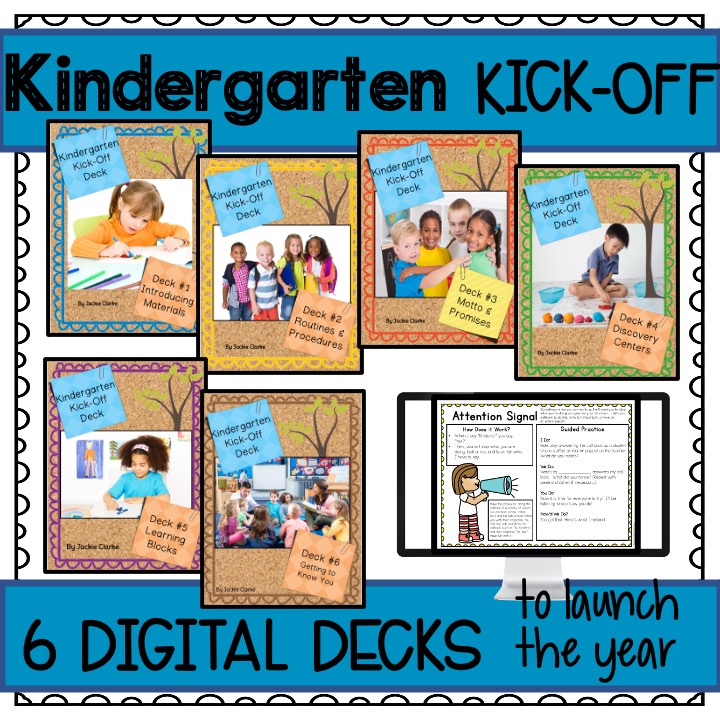Inside: Discover how to create a flexible first day plan for kindergarten, that can be reused each year when back to school time rolls around. And now it can all be done digitally! Get your free 10-day roll-out plan below.
The Need for a First Day Plan
Heading to kindergarten without a plan can feel like your own episode of Survivor.
But creating a plan is a challenging task, due to the massive amount of routines and procedures that need to be introduced.
And it’s tricky finding a balance between being clear about expectations, yet not talking too much, and making it a pleasurable first day experience for all the children.

Labor Day Blues
So every Labor Day weekend, for as long as I can remember, I have sat down to plan for those first few days of school.
Some years I used my plan book. Others I just typed up a schedule.
I also tried creating a grid or working from a list of procedures, checking them off as I go.
But, what made that all sooooo frustrating, is that I kept recreating the wheel.
Every. Single. Year.
Shouldn’t I have this all figured out by now?
The Last First Day Plan Ever
A few years ago, I finally got smart.
I sat my sweet self down and created a pretty thorough card deck that included everything I needed to remember to kick off the kindergarten year.
I typed up a card for each material, routine, center, etc. that I wanted to roll out. On each card was a quick write-up of what I wanted to “launch,” along with ideas for songs, activities and books that might make our first days together more fun and playful. I then arranged the cards in an order that helped me build my first day.
I eventually broke that one big deck down into 6 smaller decks that I now refer to as the Building Blocks of Kindergarten.

When the new school year rolls around, I combine the cards from the smaller decks to help me build my first day plan and beyond, until my entire kindergarten program is up and running.
This kick-off plan has worked really well, because everything I need to remember about introducing pencils, glue sticks, hand washing, hallway manners and more is on its own card, and in the order that I want to introduce it. But, at any moment in the day, the cards can be easily rearranged, because as we all know, those first days in kindergarten rarely go as planned.
Introducing the Digital Decks
This past summer the Kindergarten Kick-Off Decks got a big update. They now have been converted into a Google Slides version that allows you to digitally build your first day plan and project it onto your electronic whiteboard to easily share with children.

The decks no longer have to be printed and assembled and it is super easy to use the blank slides to customize the decks to better meet individual needs and teaching situations. Any new materials, centers, routines or procedures that come up each year can easily be changed, while maintaining the ease and flexibility of the overall kick-off plan.
Still a little unsure how this all works? Check out this free 10-Day Plan to see a sample of how the first 2 weeks of school might look. It also includes a more detailed first day plan.

Ready For Kindergarten
The best part of having a solid Kindergarten Kick-off Plan is that when I pull the deck out each year, I do a little “dance” knowing that I am good to go for school start-up. Goodbye Labor Day blues!

It only took me 10 years to figure it out!
For more information on each individual deck, read 6 Building Blocks to Launch the First Weeks of Kindergarten.


 7 Kindergarten Morning Work Choices for a Soft Start
7 Kindergarten Morning Work Choices for a Soft Start Curious Classroom Book Study: Begin the Day with Soft Starts
Curious Classroom Book Study: Begin the Day with Soft Starts Unpacking the Reggio Emilia Approach: Flow of the Day vs. Kindergarten Schedule:
Unpacking the Reggio Emilia Approach: Flow of the Day vs. Kindergarten Schedule: 7 Ways to Make Your Kindergarten Day Flow More Smoothly
7 Ways to Make Your Kindergarten Day Flow More Smoothly
I really like your idea of using these charts, how did you decide what to type up? For me, the first few days usually are focused on getting the routines consistent and making the expectations clear so that children are ready to learn. A lot of it is preparation work for future learning (eg. completing the title page for ISN's, lessons on AHA moments, reflection tasks, grading options…)
I really like your idea of using these charts, how did you decide what to type up? For me, the first few days usually are focused on getting the routines consistent and making the expectations clear so that children are ready to learn. A lot of it is preparation work for future learning (eg. completing the title page for ISN's, lessons on AHA moments, reflection tasks, grading options…)
The cards are my script/teaching points for introducing materials (i.e. crayons), parts of our day (i.e. reading workshop), routines (i.e. getting ready for lunch) and behavior expectations (quiet signal, class promise, etc.). I find that most of what I have to introduce at the beginning falls into these 4 categories, so I began by working from lists in each category. Then I typed up a card for each item on the list. Hope that helps!
Hello… Great idea! I use a similar concept for my class schedule but I never thought of adding scripts/teaching points. I would love to see some of your script/teaching points. Thank you for sharing.
Have you considered sharing the text?
As they are now, I can't post them because they contain little rhymes that I don't have permission to share.